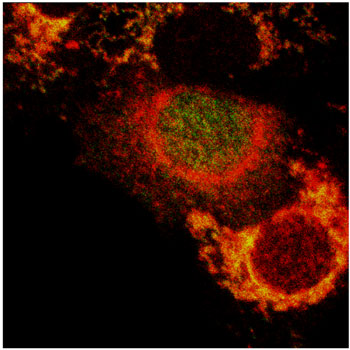| 2003 |

|
YEAR BOOK |
Trinity College Dublin
|
Cell death - the key to life
|

Even after birth our cells need to be renewed on a constant basis due to natural wear and tear and exposure to harmful agents. Every day we lose approximately 10 billion cells just to make room for new ones. In the ten minutes it will take you to read this article, seven million of your cells will have died. Every day our bodies are bombarded with agents that damage our DNA. These include UV rays, cigarette smoke and chemicals in our food. If the DNA is damaged beyond repair, then these cells must be removed quickly, and this is also achieved through apoptosis. But what exactly is apoptosis and how is it controlled?
The term apoptosis is derived from Greek and means to drop or fall off, as leaves do from the trees. It was first used in modern scientific writing in 1972, to describe a very distinct mode of cell death. During apoptosis, the cell shrinks and loses its shape as it undergoes dramatic internal reorganisation. Remarkably, the dying cell does not release any of its contents and becomes neatly packaged for disposal. Eventually the shrivelled cell is eaten by neighbouring cells and leaves no traces of its existence behind.
The analogy of a leaf falling from a tree is very apt in this context. As the leaf is dying, it shrivels and falls to the ground, where it is absorbed into the soil to be reused. It dies alone, without disturbing any other leaves. Its death allows a new leaf to grow in its place. The cycle of life and death continues undisturbed.
In a similar way, controlled apoptosis is a very desirable form of cell death. However, uncontrolled apoptosis can have catastrophic effects. In cancer for example, cells typically lose their ability to die, resulting in uncontrolled cell growth and tumour development. In many brain disorders, like Alzheimer's and Parkinson's disease, it is the other extreme. Here, too many cells die, and the brain is damaged irrevocably. It is now known that the destruction of a cell via apoptosis is a highly regulated process. This is not surprising when one considers that uncontrolled apoptosis can have disastrous consequences.
For the above reasons, deciphering how apoptosis is regulated will yield insights into the mechanisms underpinning diseases like cancer and Alzheimer's and assist the search for effective treatments. Consequently, extensive research is currently being conducted in this particular area of the life sciences. It is now known that the key players in apoptosis are enzymes called caspases. Twelve different 'flavours' of caspase are present in our cells, seven of which play a direct role in apoptosis. In a healthy cell, the caspases are present but are inactive. However, once a cell has received a signal to die, such as DNA damage, the caspases become activated and proceed to dismantle the cell. If one could imagine the process of apoptosis as controlled demolition, then the active caspases play the role of the explosives. Unless their fuses are lit, these 'explosives' are harmless, but once ignited they are deadly.
But how are these destructive enzymes activated? Understanding the mode of action of the caspases is an exciting area of current research. In the Genetics Department at TCD, Professor Seamus Martin and his research team are gearing their efforts towards understanding exactly how caspases kill. In general, caspases become activated in a domino effect. If one caspase becomes activated, this can lead to the activation of many others within the cell. Therefore, as more caspases are activated, the death signal is amplified. To use the analogy of explosives again, once one is lit, it can ignite others and collectively these can wreak controlled havoc.
Thus, the activation of the caspases is a central event in apoptosis, as it is the point of no return. For this reason, much research is now focused on the regulation of caspase activation. It is hoped that, by understanding how apoptosis is 'switched on', this will help in the treatment of many conditions where it would be desirable to kill cells, or conversely, keep them alive.
While such therapies are still unavailable, considerable progress is being made in understanding the intricacies of the cell death machinery. Due to the significant research effort, it is now clear that cells die in a highly organised manner. Many of the players involved, such as caspases, are known. Undoubtedly many more have yet to be discovered. In fact, the more we discover about apoptosis the more certain we become of one thing - that the key to life may be cell death.
* Brona Murphy was the winner of the Royal Irish Academy Science Writing Competition sponsored by Yamanouchi and The Irish Times. This is an edited version of her winning essay.
Contact: Brona Murphy, Department of Genetics, TCD; E-mail: [email protected] .